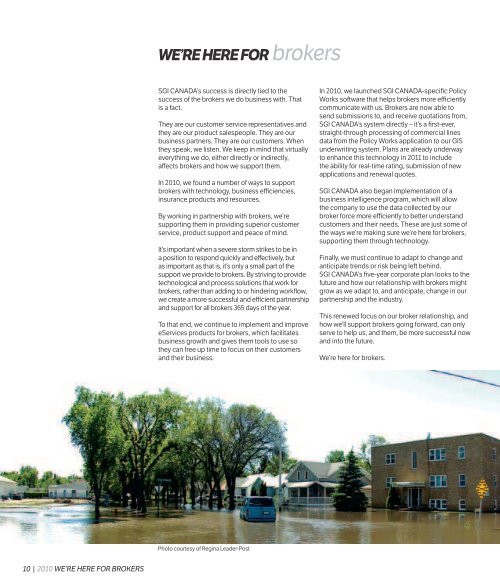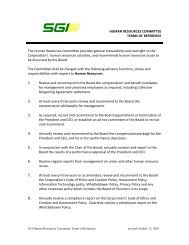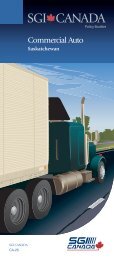Full report - SGI Canada
Full report - SGI Canada
Full report - SGI Canada
Create successful ePaper yourself
Turn your PDF publications into a flip-book with our unique Google optimized e-Paper software.
Where <strong>SGI</strong> CANADA Came From<br />
In 1944, the Government of Saskatchewan passed The Saskatchewan Government Insurance Act, creating<br />
the provincial Crown corporation that is known today as <strong>SGI</strong>. <strong>SGI</strong> was created to rectify problems in the<br />
Saskatchewan insurance industry. At that point in time, poor economic conditions had driven many<br />
insurers out of the province.<br />
<strong>SGI</strong>’s mandate since its inception has been to provide comprehensive, affordable insurance protection to<br />
the people of Saskatchewan. In 1980, legislated changes to The Saskatchewan Government Insurance Act,<br />
1980 and The Automobile Accident Insurance Act distinguished between the compulsory vehicle insurance<br />
program for the province (the Saskatchewan Auto Fund) and the competitive insurer offering additional<br />
property and casualty products (<strong>SGI</strong> CANADA).<br />
<strong>SGI</strong> CANADA is the trade name that <strong>SGI</strong> operates under to provide competitive, quality property<br />
and casualty (P&C) insurance products in Saskatchewan. P&C product offerings include policies for<br />
automobile, home, farm and commercial enterprises. In addition, <strong>SGI</strong> CANADA, through its subsidiary<br />
<strong>SGI</strong> CANADA Insurance Services Ltd., offers similar products in six other provinces across <strong>Canada</strong>.<br />
The <strong>SGI</strong> CANADA annual and quarterly <strong>report</strong>s are available on its website at www.sgicanada.ca.<br />
The operations in provinces outside Saskatchewan are important to the Corporation in order to spread<br />
risk, maintain and create jobs in Saskatchewan, and increase economic returns for <strong>SGI</strong> CANADA’s<br />
shareholder, Crown Investments Corporation of Saskatchewan (CIC). In 1993, <strong>SGI</strong> CANADA Insurance<br />
Services Ltd. began offering P&C insurance in Manitoba. In 2001, <strong>SGI</strong> CANADA Insurance Services Ltd.<br />
became the majority shareholder (75%) of the Insurance Company of Prince Edward Island (ICPEI) and<br />
also purchased 100% of the shares of Coachman Insurance Company (Coachman). Coachman operates<br />
in Ontario while ICPEI operates in Prince Edward Island, New Brunswick and Nova Scotia. <strong>SGI</strong> CANADA<br />
Insurance Services Ltd. has also been operating in Alberta since 2006.<br />
The Corporation is a provincial Crown corporation wholly owned by CIC. The following organizational<br />
chart illustrates the Corporation’s ownership structure:<br />
Crown Investments Corporation<br />
of Saskatchewan<br />
As a provincial Crown corporation, <strong>SGI</strong> CANADA is not subject to federal or provincial income taxes. Its<br />
subsidiaries are not provincial Crown corporations, thus they are subject to federal and provincial income<br />
taxes. The consolidated financial results of <strong>SGI</strong> CANADA are included in CIC’s consolidated financial<br />
statements.<br />
At December 31, 2010, the Corporation employed over 1,800 people, including those employees who<br />
work directly for the Saskatchewan Auto Fund. <strong>SGI</strong> CANADA operates with a network of 256 independent<br />
brokers throughout Saskatchewan, as well as 249 brokers operating in Manitoba, Alberta, Ontario, Prince<br />
Edward Island, New Brunswick and Nova Scotia. <strong>SGI</strong> CANADA’s corporate head office is located in Regina,<br />
Saskatchewan.<br />
The Property and Casualty Insurance Business Environment 1<br />
<strong>Canada</strong>’s highly competitive P&C industry consists of approximately 230 private and governmentowned<br />
insurers. The P&C industry covers all types of insurance other than life and health insurance. The<br />
automobile insurance sector continues to be the largest contributor to gross premium volume at half of all<br />
premiums. Property insurance ranks second, followed by liability insurance and other insurance.<br />
Insurance is a mechanism for spreading risk, for sharing the losses of the few among the many. Insurance<br />
makes the life of an individual or business enterprise more stable by allowing people and businesses to<br />
engage in many ventures without having to set aside reserves to meet the financial requirements that<br />
may arise from certain types of losses. Insurance also facilitates the granting of credit by protecting the<br />
investments of both lenders and borrowers.<br />
Insurance can be considered a large pool into which policyholders place their premiums. 2 This pool<br />
provides for payment of losses suffered by those who have claims and for the cost of running the insurance<br />
company. Sometimes, total premiums are insufficient to pay claims and operating expenses, however,<br />
insurers also use investment earnings to pay claims and keep premiums lower than they might<br />
otherwise be.<br />
P&C insurance companies are supervised and regulated at the federal and provincial levels. The federal<br />
regulator, the Office of the Superintendent of Financial Institutions, is responsible for the solvency and<br />
stability of P&C insurance companies registered federally. Provincial authorities supervise the terms<br />
and conditions of insurance contracts and the licensing of companies, agents, brokers and adjusters,<br />
along with monitoring the solvency and stability of provincially registered companies. <strong>SGI</strong> CANADA’s<br />
subsidiaries are provincially regulated insurance companies.<br />
Saskatchewan Government Insurance (<strong>SGI</strong>)<br />
operating under the trade name of<br />
<strong>SGI</strong> CANADA<br />
<strong>SGI</strong> CANADA Insurance Services Ltd.<br />
Saskatchewan Auto Fund<br />
(Administered by <strong>SGI</strong>)<br />
Since automobile insurance is compulsory in <strong>Canada</strong>, unlike home and business insurance, it is the most<br />
regulated area that P&C companies operate within. Regulation of premium rates is based on claims and<br />
other costs of providing insurance coverage, as well as projected profit margins. Regulatory approvals can<br />
limit or reduce premium rates that can be charged, or delay the implementation of changes in rates. The<br />
Corporation’s automobile premiums are subject to rate regulation in Alberta, Ontario, Prince Edward Island,<br />
New Brunswick and Nova Scotia, which represents approximately 13.8% of the consolidated net premiums<br />
earned in 2010.<br />
The industry is a major part of the social and economic fabric of <strong>Canada</strong>. P&C insurers invest mainly in<br />
domestic government bonds, corporate bonds, preferred shares and common stocks. Government<br />
regulations are in place for the P&C industry that require these investments to be made using a prudent<br />
person’s viewpoint.<br />
Coachman Insurance<br />
Company (Coachman)<br />
The Insurance Company<br />
of Prince Edward Island<br />
(ICPEI)<br />
1<br />
Adapted from “Facts About Property and<br />
Casualty Insurance In <strong>Canada</strong>” prepared by the<br />
Insurance Bureau of <strong>Canada</strong>, Facts 2009.<br />
2<br />
This and other terms are defined in the glossary<br />
included in this annual <strong>report</strong>. The glossary<br />
begins on page 105.<br />
The P&C industry also utilizes reinsurance. Reinsurers, most of which are international organizations,<br />
spread risks by writing business with insurers in several countries and in many regions around the world.<br />
Insurance companies pay premiums to reinsurers in exchange for an agreement to have a proportion of<br />
their claims paid for them, particularly in the event of a major loss or catastrophe. Reinsurance is one of<br />
many tools used by insurers to guarantee that they will meet every obligation to pay legitimate claims.<br />
20 | 2010 MANAGEMENT’S DISCUSSION AND ANALYSIS MANAGEMENT’S DISCUSSION AND ANALYSIS 2010 | 21















